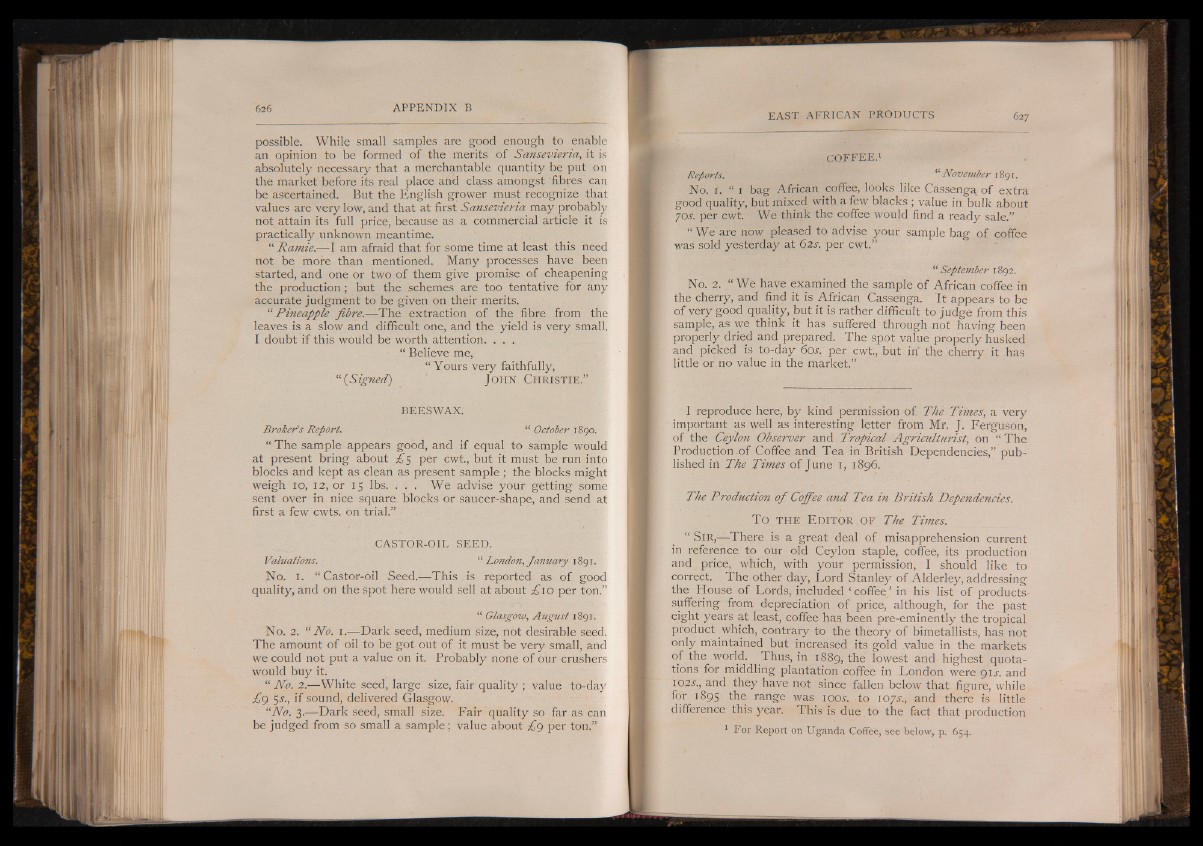
possible. While small samples are good enough to enable
an opinion to be formed of the merits o f Sansevieria, it is
absolutely necessary that a merchantable quantity be put on
the market before its real place and class amongst fibres can
be ascertained. But the English grower must recognize that
values are very low, and that at first Sansevieria may probably
not attain its full price, because as a commercial article it is
practically unknown meantime.
“ Ramie.— I am afraid that for some time at least this need
not be more than mentioned. Many processes have been
started, and one or two of them give promise of cheapening
the production; but the schemes are too tentative for any
accurate judgment to be given on their merits.
“ Pineapple fibre.—-The extraction of the fibre from the
leaves is a slow and difficult one, and the yield is very small.
I doubt if this would be worth attention. . . .
“ Believe me,
“ Yours very faithfully,
“ {Signed) ' JOHN CHRISTIE.”
BEESWAX.
Brokers Report. “ October 1890.
“ The sample appears good, and if equal to sample would
at present bring about fi^ per cwt., but it must be run into
blocks and kept as clean as present sample ; the blocks might
weigh 10, 12, or 15 lbs. . . . We advise your getting some
sent over in nice square blocks or saucer-shape, and send at
first a few cwts. on trial.”
CASTOR-OIL SEED,
Valuations. “ London, January 1891.
No. I. “ Castor-oil Seed.-—This is reported as of good
quality, and on the Spot here would sell at about £10 per ton.”
“ Glasgow, August 1891.
No. 2. “ No. I.— Dark seed, medium size, not desirable seed.
The amount of oil to be got out of it must be very small, and
we could not put a value on it. Probably none of our crushers
would buy it.
“ No. 2.— White seed, large size, fair quality ; value to-day
fig 5-f., if sound, delivered Glasgow.
“No. 3.— Dark seed, small size. Fair quality so far as can
be judged from so small a sample; value about fig per ton.”
COFFEE.1
Reports. “ November 1891.
No. 1. “ 1 bag African coffee, looks like Cassenga of extra
good quality, but mixed with a few blacks ; value in bulk about
70J. per cwt. We think the coffee would find a ready sale.”
“ We are now pleased to advise your sample bag of coffee
was sold yesterday at 62s. per cwt.”
“ September 1892.
No. 2. “ We have examined the sample of African coffee in
the cherry, and find it is African Cassenga. I t appears to be
of very good quality, but it is rather difficult to judge from this
sample, as we think it has suffered through not having been
properly dried and prepared. The spot value properly husked
and picked is to-day 60s. per cwt., but in the cherry it has
little or no value in the market.”
I reproduce here, by kind permission of The Times, a very
important as well as interesting letter from Mr. J. Ferguson,
of the Ceylon Observer and Tropical Agriculturist, on “ The
Production .of Coffee and Tea in British Dependencies,” published
in The Times of June 1, 1896.
The Production o f Coffee and Tea in British Dependencies.
T o THE E d i t o r o f The Times.
I S ir,— T here is a great deal of misapprehension current
in reference to our old Ceylon staple, coffee, its production
and price, which, with your permission, I should like to
correct. The other day, Lord Stanley of Alderley, addressing
the House of Lords, included ‘ coffee/ in his list of products-
suffering from depreciation of price, although, for the past
eight years at least, coffee has been pre-eminently the tropical
product which, contrary to the theory of bimetallists, has not
only maintained but increased its gold value in the markets
of the world. Thus, in 1889, the lowest and highest quotations
for middling plantation coffee in London were 911 and
I02i., and they have not since fallen below that figure, while
for 1895 the range was i o o j \ to 107^, and there is little
difference this year. This is due to the fact that production
1 For Report on Uganda Coffee, see below, p. 654.